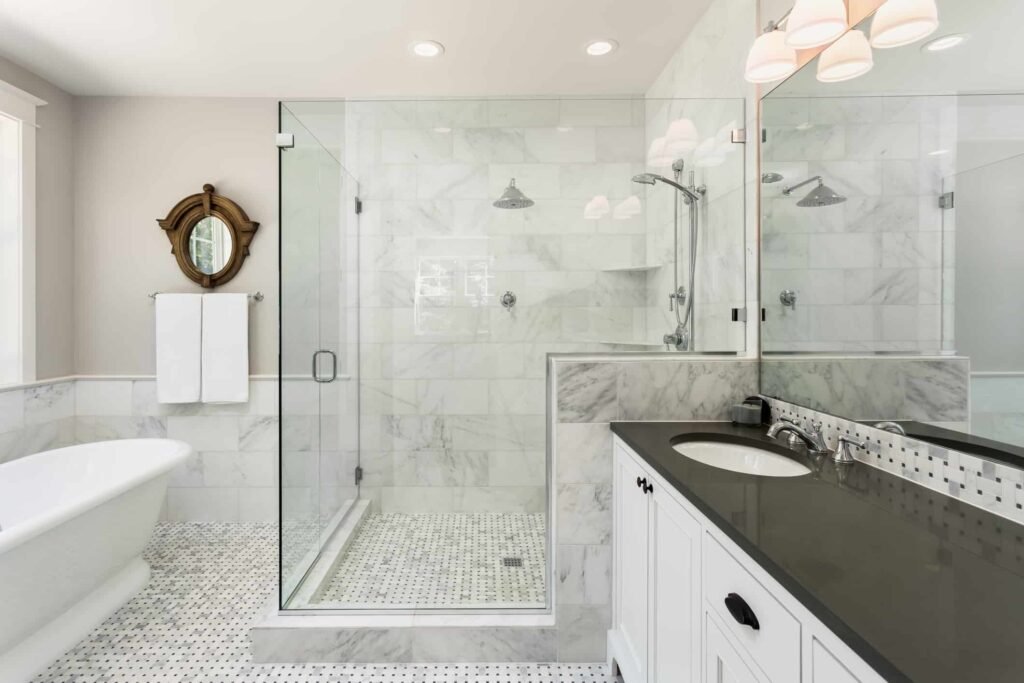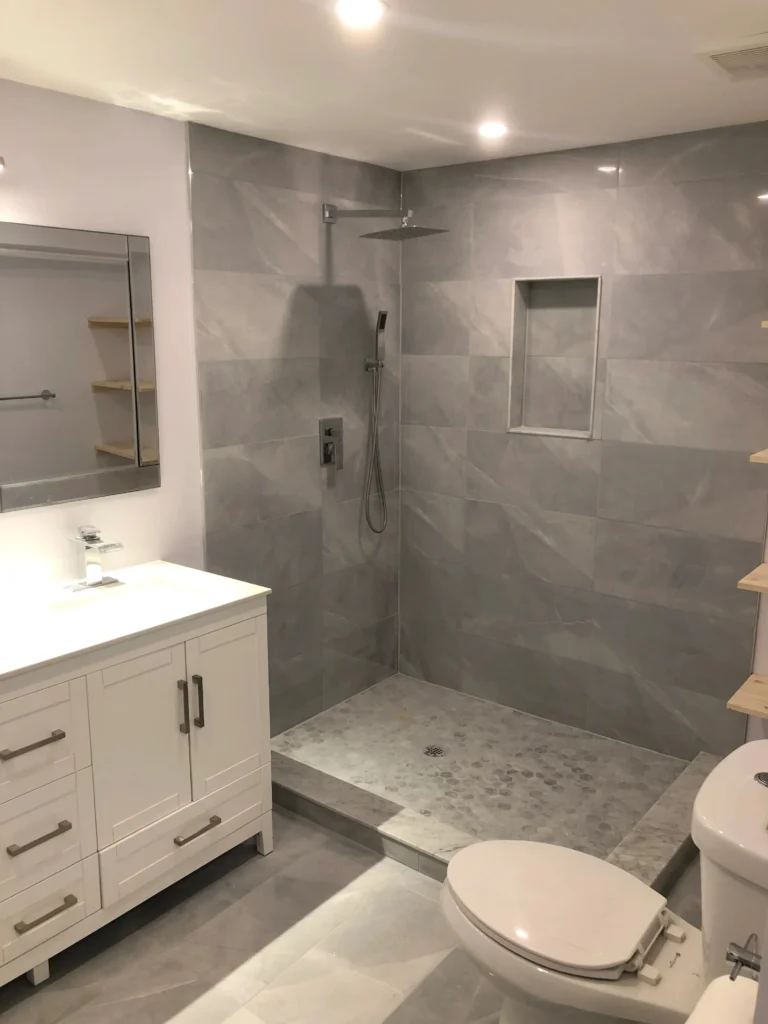I’m Robbie Fraikin, owner of Raakss Reno. Over the years, I’ve renovated hundreds of bathrooms for homeowners across the GTA, and one of the most rewarding projects I take on is building walk-in showers for seniors.
As people age, the bathroom—usually a place of comfort—can become one of the riskiest spaces in the home. Slippery tiles, high bathtub edges, and poor lighting can make daily routines difficult or even dangerous. That’s where walk-in showers come in. They combine safety, accessibility, and elegance to help older adults stay independent longer, without sacrificing the look and feel of a beautiful modern bathroom.
In this guide, I’ll share what I’ve learned about designing the perfect walk-in shower for seniors—from choosing the right materials to maximizing safety features—and how my team at Raakss Reno helps homeowners make this important upgrade with confidence.
Why Walk-In Showers Are Ideal for Seniors
As we age, simple movements—like stepping over the edge of a bathtub—can become challenging. A walk-in shower eliminates this problem with a low or zero-threshold entry, allowing easy access whether you’re walking in, using a mobility aid, or need assistance.
The biggest advantage is safety. Traditional bathtubs have edges that are 15–20 inches high, while a walk-in shower threshold is often less than 2 inches—or even flush with the floor in a true curbless design. That difference drastically reduces the risk of slips and falls, which are among the leading causes of injury for seniors in the home.
At Raakss Reno, when we remodel bathrooms for accessibility, we focus on comfort, practicality, and design harmony. Just because a shower is safe doesn’t mean it has to look institutional. With modern bathroom design trends, we can create spaces that feel luxurious and accessible at the same time.
If you’re considering a full remodel, my bathroom renovation planning guide breaks down how to prepare your home for upgrades like these.
Safety Features Every Senior Walk-In Shower Should Have
When I design walk-in showers for seniors, I focus on the details that make daily use both safe and stress-free. Here are the features I always recommend including:
1. Slip-Resistant Flooring
This is the foundation of safety. Slippery floors are one of the biggest hazards in any bathroom, but especially for older adults. I recommend non-slip tiles or textured vinyl flooring that offer traction even when wet. For clients interested in warmth underfoot, we can also integrate heated flooring systems beneath anti-slip tiles for added comfort. You can learn more about choosing durable flooring in my bathroom flooring materials guide.

2. Grab Bars and Support Handles
Strategically placed grab bars make a huge difference in confidence and safety. I usually install them near the shower entrance, along the wall, and close to seating areas. Modern grab bars come in sleek designs and finishes that complement your fixtures instead of looking clinical.
3. Built-In Seating
A built-in or foldable seat allows seniors to shower comfortably without standing for long periods. It’s a small addition that adds tremendous safety value, especially when paired with handheld showerheads. I often design these seats with water-resistant materials like quartz or tile to match the shower walls seamlessly.

4. Handheld Showerheads
Adjustable, handheld showerheads make showering much more flexible. They can be mounted at different heights, making them ideal for anyone with limited mobility. Combined with thermostatic controls that prevent sudden temperature changes, they create a safer, more enjoyable showering experience.
5. Low or Zero-Threshold Entry
This is one of the defining features of a walk-in shower. By eliminating the barrier of a high step, seniors can safely walk or roll in without fear of tripping. We ensure the slope is designed to drain water efficiently, preventing puddles or leaks.
6. Proper Lighting
Lighting is often overlooked in accessibility design, but it’s one of the most critical components. We use layered lighting—such as ceiling lights, vanity illumination, and shower-safe recessed fixtures—to reduce shadows and brighten every corner. If you’re exploring lighting upgrades, check out my bathroom lighting fixtures guide.
Designing for Independence and Dignity
One of my main goals when working on senior-friendly bathroom designs is to create a space that promotes independence. Seniors should be able to bathe safely without needing constant assistance. That’s why we focus on open layouts, sturdy but discreet supports, and user-friendly fixtures.
I’ve met many homeowners who worry that accessible design will make their bathroom look like a hospital. My answer? Not if it’s done right. Walk-in showers can be just as beautiful as they are functional. With elegant tile choices, soft lighting, and modern glass enclosures, we can achieve a spa-like aesthetic that feels warm and inviting. For inspiration, you can browse my best bathroom tile ideas.
Accessibility isn’t about compromise—it’s about designing smarter. Every curve, handle, and surface should support ease of movement while maintaining an elevated sense of style.
Materials That Work Best in Walk-In Showers for Seniors
Choosing the right materials is crucial for longevity, safety, and maintenance. I often guide clients through three main categories:
Tiles: Porcelain and ceramic tiles are popular for their non-slip finishes and easy cleaning. I recommend larger tiles for fewer grout lines, which also reduce mold buildup.
Glass: Tempered glass doors or partitions make the shower feel open and bright while keeping the design barrier-free. Frosted glass offers more privacy if preferred.
Fixtures: Brushed nickel, stainless steel, or matte black finishes are stylish and easy to grip even with wet hands.
We also apply mold-resistant sealants and waterproof membranes beneath all tiled surfaces to ensure durability. You can learn more about protecting against moisture in my guide on how to prevent bathroom mold buildup.
Customization Options for Every Home
Every home and every person is different, which is why walk-in showers for seniors should be custom-built to match the user’s mobility needs and bathroom layout.
Some of the customization options we offer at Raakss Reno include:
Built-in shelving or niches for easy access to toiletries without bending down.
Wide glass doors or open-concept layouts for wheelchair accessibility.
Integrated bench seating made from matching tile or solid surface materials.
Smart temperature controls that prevent scalding and maintain a consistent water temperature.
Shower curtains instead of glass doors for easier wheelchair entry.

If you’re thinking about a full remodel, my bathroom renovation ideas article explores creative ways to incorporate accessibility without compromising aesthetics.
Cost of Walk-In Showers for Seniors
The cost of installing a walk-in shower for seniors depends on the size of your bathroom, materials chosen, and the complexity of modifications needed. In my experience, most homeowners in the Greater Toronto Area can expect to spend between $8,000 and $18,000 for a full renovation.
Adding accessibility features like grab bars, non-slip flooring, and custom seating can add to the cost but are well worth the investment for long-term comfort and safety. For a deeper look at bathroom remodeling budgets, check out my guide on the average cost of bathroom renovation in Toronto.
I always remind clients that these upgrades can increase property value while making daily living easier and safer. Accessibility is not just a health decision—it’s a smart home investment.
Walk-In Shower vs. Traditional Bathtub
When homeowners ask me whether they should replace their bathtub with a walk-in shower, my answer depends on lifestyle. For seniors or anyone planning to age in place, the walk-in shower is hands-down the safer and more practical choice.
Bathtubs require lifting your leg over a tall ledge, while a walk-in shower provides direct, step-free access. The open design also allows caregivers or family members to assist more easily if needed. For clients who prefer a luxury experience, I often design walk-in showers with rainfall showerheads, body jets, and built-in benches for relaxation.
If you’re thinking of making the switch, my article on should you convert your bathtub to a walk-in shower offers a full breakdown of benefits and considerations.
Ensuring Long-Term Safety and Maintenance
Once your new shower is installed, regular upkeep ensures it stays safe and functional. Cleaning with non-slip-safe products, checking caulking and grout annually, and ensuring proper ventilation all help extend the life of your shower.
A clean, dry environment also reduces the chance of mold or mildew growth. You can read my full guide on how to prevent mold buildup in your bathroom for more practical tips. I also suggest scheduling minor maintenance checks every few years to keep everything in top shape.
A Safer, Smarter Bathroom Starts Here
A walk-in shower isn’t just a renovation—it’s a transformation of how you experience your bathroom. It’s about regaining independence, safety, and comfort without sacrificing design. As someone who’s spent years crafting bathrooms that blend accessibility with style, I can confidently say that walk-in showers for seniors are one of the most impactful upgrades you can make.
Whether you’re planning for yourself, a parent, or a loved one, my team at Raakss Reno can help you design a space that feels secure, beautiful, and built to last. Visit my services page or contact me today to get started on your next bathroom renovation.
